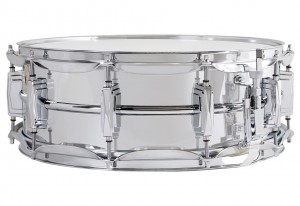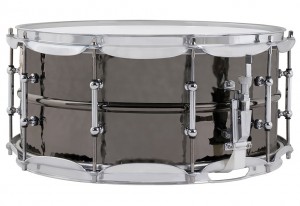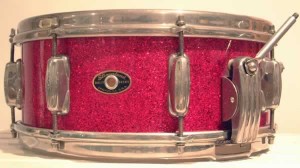The Best Snare Drums For The Recording Studio
It’s no overstatement to say that a good snare sound is essential to the backbone of almost any kind of pop record – whether that means hip hop, country, speed metal, R&B, punk rock, psychedelia, shoegaze, adult contemporary, jazz or straight up rock n’ roll. So every recording studio should have at least a couple of great-sounding snare drums tuned up and ready to go.
Deciding what snares to have on hand however, can be a daunting task to those who are unfamiliar with what’s out there. Even to the initiated, it can sometimes seem as if there are as many snare drums on the market as there are players.
Thankfully, there are a few stalwarts that never seem to go out of style, and every studio owner, engineer, producer and recording drummer would be well-served to get acquainted with them. Here are a few classics that could help establish the foundations of a small-but-versatile collection of snare drums for any studio.
Must-Have Snare Drum #1: Aluminum Shell, Standard-Size
The Signature Model: Ludwig Supraphonic 14” x 5”
The Ludwig Supraphonic is arguably the most-recorded snare drum in history. And it’s one of my own personal favorites. Its sound is iconic and instantly familiar: Bright, clear, powerful – anything but neat and clean. And its trademark resonance is just as satisfying and memorable as its attack.

Ludwig Supraphonic
Buy it new on Sweetwater, B&H, Thomann, or Amazon. Look for deals on Reverb.
If left unmuffled and equipped with a single-ply beater head, the decay of Supraphonic can sound wet – almost sloshy – although in an even and full-bodied kind of way. From there, it can be deadened down with moon gels or even wallets and tea towels if desired, without ever losing its trademark articulation and complexity.
To hear the sound of a well-tuned Supraphonic is to recognize it: This is the sound of a solid rock n’ roll backbeat. And the design and construction of this aluminum snare drum has remained essentially unchanged for more than 40 years. I personally own a 14” x 5” model and take it with me whenever I’m tracking drums at a studio that doesn’t have one.
If a studio had to have only one snare drum, it would be hard to go wrong with a Ludwig Supra. Not only is it familiar-sounding, but it’s flexible as well. The drum’s 10 lugs allow for a wide tuning range, and it can go from wet-and-ringy to dry-and-controlled, while remaining convincing at every stop along the way.
At around $450, brand new Supraphonics don’t come dirt cheap. But they can be a sensible and affordable choice for many studios, drummers and producers to have on hand.
For those who want to spend even less, vintage 8-lug Ludwig Acrolites and Ludwig Standards are easily found on the used market, often going for 25% – 50% of the cost of a new or vintage Supra. These models sound a little bit drier than the Supraphonic, lacking just a bit of its complex, trademark resonance, but they are certainly in the same family. They can even border on indistinguishable from the original when you’re going for more muffled or controlled drum sounds.
As far as new options go, Pearl makes a snare drum called the “Sensitone” that does a decent emulation of the Supra at about half the price. The aluminum version (and also the even brighter steel model) have a pretty convincing tone.
The standard Supraphonic can be heard on everything from classic rock records by The Kinks, The Rolling Stones, The Beatles, Jimi Hendrix and Cream to jazz legends like Lionel Hampton and Joe Morello of the Dave Brubeck Quartet, to prolific studio drummers like Hal Blaine, who recorded on more #1 pop hits, between 1961 and 1976, than perhaps anyone else in the world. (His drumming can be heard on some of the biggest cuts from The Ronettes, The Beach Boys, The Carpenters, The Byrds, Simon & Garfunkel, Elvis, The Supremes, and both Frank and Nancy Sinatra.)
For those who want a bit more resonance and power (and a little less sensitivity from the snare-band on the resonant side) the 6.5” depth, favored by the likes of John Bonham and Alex Van Halen, is a perennial favorite.
Must-Have Snare Drum #2: Brass Shell, Extra-Deep
The Signature Model: Ludwig Black Beauty 14” x 6.5”
The second drum on our list of studio standards is also a Ludwig: the massive and drool-inducing Black Beauty, 14” x 6.5”.
If the standard Supraphonic is the sound of so many classic rock records, then the Black Beauty is the stock sound of rock of a heavier and more modern variety. Ironic then, that it’s actually based on an even older material used in drum construction.
In the first half of the 20th century, Ludwig’s metal snares were made out of brass, rather than the aluminum that has been used in the Supraphonic for so long. Brass offers a slightly different resonant character, and offers just a bit more low-end power and punch than an aluminum model of the same size.

14″ x 6.5″ Hammered Brass Black Beauty
Buy it new on Sweetwater, B&H, Thomann, or Amazon. Look for deals on Reverb.
If you plan on working on a lot of heavier rock music, then the Black Beauty is a must-have. I find it a little less versatile than the Supra, but those are just my tastes, and whenever it does fit, it’s just the thing, and no other type of drum will quite do.
The Black Beauty is on the expensive side – often $700 or more depending on features and finishes. But it’s such a popular drum that there are many worthy homages to it. World Max and Porkpie make equivalent brass models that can be as little as half the price. And even Ludwig is in on the game of undercutting itself, making a lower-cost “Black Magic” model inspired by the originals.
For something a bit different, a vintage 14” x 5.5” chrome-over brass Rogers Powertone or Dynasonic can offer beefy power and brash articulation with a character all its own.
Another interesting substitute comes from an unexpected place: On a budget, you might try the common, affordable, sometimes unfashionable 6.5”-deep steel Pearl Export. It’s a different animal entirely, but to my ear it can do a great job of capturing the vibe of the big 80s power snare.
Must-Have Snare Drum #3: Wood Construction, Standard Size
The Signature Model: Slingerland Radio King, Single-Ply Maple 14” x 5”
It’s a bit harder to pick a single iconic wooden snare drum. Some say it’s Slingerland’s Radio King. Some say Gretsch, some say Rogers, and some prefer more modern updates from companies like Brady, DW, Tama or Spaun.
Whatever your preference, the high-class option is probably single-ply maple, which is a great way to go if you can afford one, and it’s a popular choice for a reason. A good sngle-ply maple can give a nice dry “crack” to the drum strike that’s impossible to achieve with even the best of metal snares.
If you’re recording less heavy drumming I’d easily recommend a good maple 14” x 5” snare drum ahead of the much-worshiped Black Beauty on the list, putting it neck-and-neck with the Supraphonic for the #1 “must-have” spot.
There are two general ways to go with this type of drum: vintage or modern. A vintage-style maple snare may have a little less resonance and volume thanks to older styles of hardware that don’t let the shell vibrate quite so freely.

1950’s Slingerland Radio King. Photo courtesy of Vintage DrumGuide.com
Buy it new on Sweetwater, B&H, Thomann, or Amazon. Look for deals on Reverb.
Single-ply maple, of course, isn’t the only way to go. It’s just happens to be one of the most common and well-balanced choices for an all-around high-performance stock snare drum. Different materials offer different tones and textures.
One of the other common materials – particularly on entry-level and intermediate student kits – is a blend of mahogany with poplar or even basswood. An interesting and offbeat mahogany blend can sound thick and throaty in a way that can be just the thing sometimes.
If you have the cash for it, I’d recommend maple as a primary wood snare, but if you want an interesting backup or are strapped for resources, one of these more affordable composite wood drums can be a good call.
If you find a very old snare drum made of mahogany, it may be made of solid mahogany through and through. These are often just as nice as maple, but with a significantly darker and more full-bodied tone. They can have a very attractive sound if you’re attracted to textures that are bit smoother and more subdued.
There are a few other wood types that are popular as well: Birch and pure poplar offer a slightly “scooped” sound that’s clean, articulate and can record well. One of my sleeper favorites is oak, which also has a slight midrange scoop, but an overall balance that rivals maple for impact and versatility. The Yamaha Oak Custom is a very nice change of pace in my book.
Be careful – or at least aware – while purchasing used and vintage wood drums. Unlike metal snares, their bearing edges (the part of the shell that makes contact with the drumhead) can easily become badly worn with age. I’ve sometimes found wood drums with poorly defined or even awkwardly rebuilt bearing edges can sound interesting and growly in their own way. But even at their best, they’ll have a limited tuning range, and it can sometimes be very hard to hammer out dissonant resonances in them. I’d recommend a wood snare with worn out old bearing edges as a backup only or an alternate color only.
All the Rest: Exotic Materials, Alternate Sizes, Similar Drums with Experimental Heads
Long story short: Any studio would be well served with at least one great wood snare and one great metal snare at 14”x5”. Aluminum and maple are a natural starting place for these. For those who want something with a little more power, a brass snare is a no-brainer – Especially if it’s a big one.
Once you have these bases covered, it’s not a bad idea to look at snare drums that will really stretch your palette of colors.
More diminutive snares like 13”x3” piccolos, or (my preference) a small-but-deep “popcorn snare” at 10”x6” or 8.5”x5” are a radical departure from the rest. Some snares like Pearl’s custom Omar Hakim 13”x5” model can be a nice compromise between both worlds.
You can also go in the opposite direction and try some vintage field drums or modern marching snares that can reach up to 11” or 12” deep. And it’s valuable to realize that with a little DIY know-how, you may be able to convert just about any sized tom into a snare drum.
Lastly, if you have more than one of the same basic type drum of drum, don’t despair. Different heads can lead to dramatically different sounds. I have my Ludwig Supraphonic set up to be open, complex and resonant, and my quite similar Ludwig Standard tuned up with thicker heads that give it a fulfilling dry, muted “smack.”
There are plenty of good drums out there these days, but these classics are classics for good reason. I’d never part with my Supra, and I’m always looking for an excuse to put a brass Black Beauty or a nice vintage-style wood snare up on the stand.
Although we musician-types are typically known to be a free-spirited bunch, we can also be pretty conservative when it comes to tastes in gear and tone. The gear that sounds best to us is often that which sounds instantly familiar – whether that’s because of tubes, tape, transformers or algorithms, or because of familiar quirks of construction.
The world of snare drums is no different. There are a few shapes, sizes, materials and designs that instantly sound familiar and therefore “good” to most ears. The options listed above are a great place to start. But you never know: if your next great drum sound comes from a metal coffee can, a plastic paint tub or wooden cajon, I wouldn’t be the least bit surprised.
Justin Colletti is a Brooklyn-based audio engineer, college professor, and journalist. He records and mixes all over NYC, masters at JLM, teaches at CUNY, is a regular contributor to SonicScoop, and edits the music blog Trust Me, I’m A Scientist.
Please note: When you buy products through links on this page, we may earn an affiliate commission.







Will Schillinger
February 26, 2013 at 9:05 pm (12 years ago)Very nice Justin.
BoNz THARPE
February 27, 2013 at 12:36 pm (12 years ago)thanks for one of the easiest to read best posts about snare drums in a non-drummer mag/blog. Im now inspired to buy a supraphonic and a slingerland (already have a black beauty) and oh yea I used to have Justin’s popcorn snare in my studio 🙂
Harry J. Cangany Jr.
February 28, 2013 at 12:09 pm (12 years ago)I enjoyed your article and observations and agree. Those are great choices.
Shane DuShane
March 1, 2013 at 11:30 am (12 years ago)Would gladly pay some money for those samples of those snares.
Rainie Flores
March 25, 2013 at 10:01 pm (12 years ago)Thank you for this great post. This is very informative. This post is going to help every recording studio owner like me. – http://www.soundops.com/
TomParmenter
August 28, 2013 at 1:19 pm (12 years ago)My good old Supraphonic (pre-Ringo according to the serial number) sounds just great despite the spotty chrome plating. I see used Supraphonics for under $300. My kit also has a very mellow sounding Yamaha snare that I use as a fourth tom or as a spare snare for breaks, etc. You can’t really get a smashing backbeat out of it but it does add flavor. Two snares, twice the fun.
I have heard a rumor that despite sponsorship deals, etc, some amazingly high percentage of drummers use Ludwig snares both for performance and recording.
Sarah Moore
October 9, 2013 at 2:04 pm (12 years ago)I am a big fan of Adult Contemporary music and the only radio station that plays a wide range of this music is 97.9 WRMF. I am also kept updated on the station’s latest promotions and community events. Visit their website for live streaming at http://www.wrmf.com .
ApathyNihilism
July 1, 2014 at 7:33 pm (11 years ago)Nice groove! Great sounding snares, very well tuned as well.
El Torito
November 13, 2015 at 8:21 pm (9 years ago)My favorite Supra for recording is the pre-serial keystone badge aluminum shell. This was the transitional period from brass, where the shell and rims were aluminum, and the snare beds were the “pinched” types, which were on the heavy brass snares. Those snare beds seem to give the drum an added element. You can find them reasonably priced because the chrome is usually in terrible shape.
abidabiW
December 18, 2015 at 3:08 pm (9 years ago)Nice article – Just to note….the wooden Ludwig’s along with the metal shell varieties were always extremely popular on countless records – a very familiar tone…much more than Slingerland……LUDWIG drum tones are truly a major part of American music….and the jasper wood shells made by Gretsch were another popular drum as well…………Slingerland Radio Kings’ mahogany and maple shells were made famous by Krupa and others….mostly considered top of the line especially during the 40/50’s……..along with Ludwig’s own
predecessor…WFL drums……….thanks again for sharing this very cool article! 🙂
armand
February 5, 2016 at 10:50 pm (9 years ago)im customizing a 14 x 9 wood snare ,with 10 holes rim,, i want a loud snare drum, would it be possible for me to create loud sound from this project? ive heard metal snare are loud compare to wood? or should i put a metal sheet inside the wood shell to gain my expected sound
s? please help,,
ali gator
July 21, 2016 at 2:14 pm (9 years ago)would not trade my 1968 Rogers Dynasonic for anything!!
drumandpace
July 29, 2016 at 9:34 am (9 years ago)Two very good snare drums indeed! I’d want to add the older Pearl Free Floating (Steel) Snares to the list. They have an amazingly deep punch that suits harder rock music very well.
Thanks for this great article!
Cheap Drum Set
July 6, 2017 at 6:37 am (8 years ago)This is a very good and more necessary post